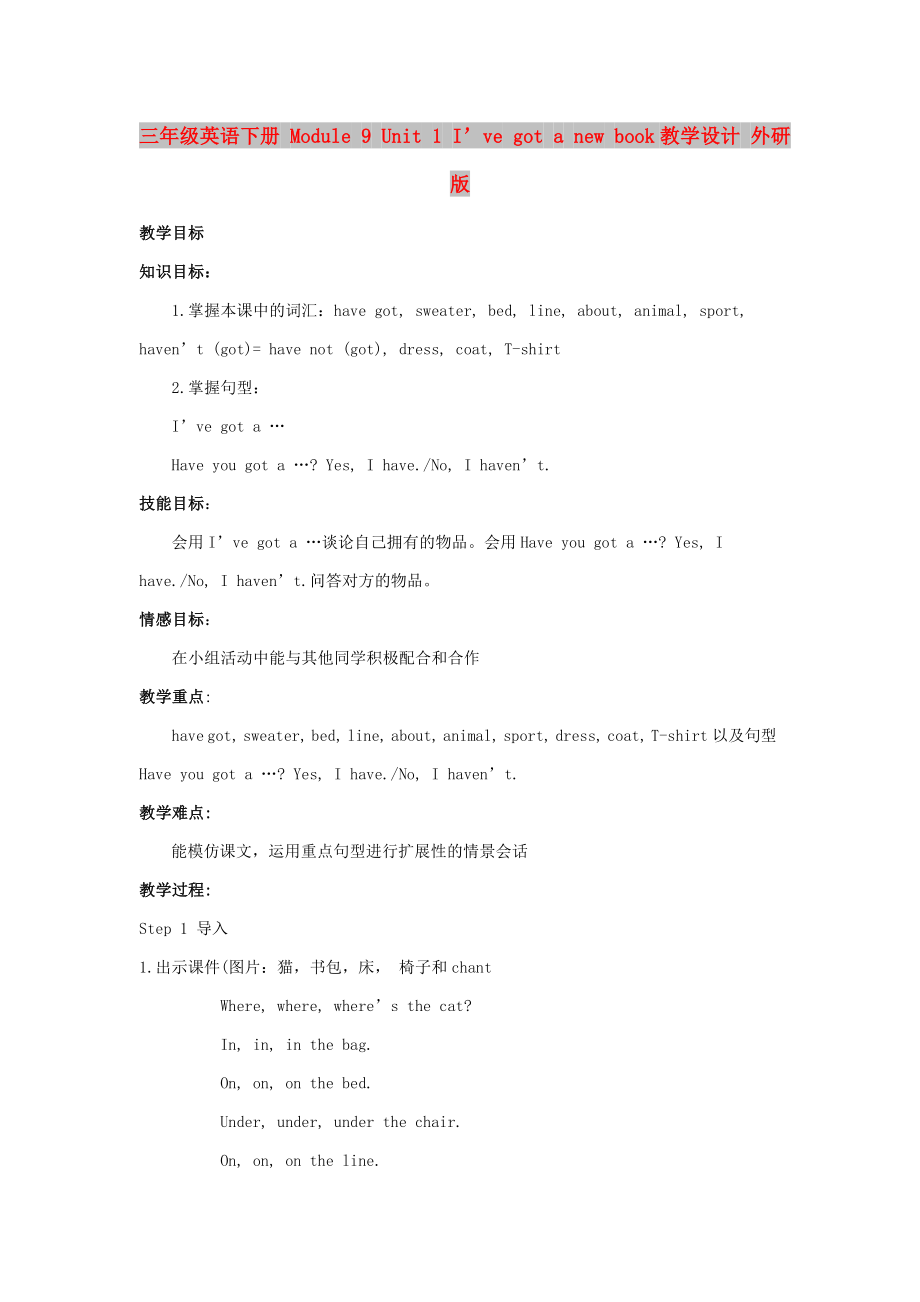《三年級(jí)英語下冊(cè) Module 9 Unit 1 I’ve got a new book教學(xué)設(shè)計(jì) 外研版》由會(huì)員分享����,可在線閱讀,更多相關(guān)《三年級(jí)英語下冊(cè) Module 9 Unit 1 I’ve got a new book教學(xué)設(shè)計(jì) 外研版(5頁珍藏版)》請(qǐng)?jiān)谘b配圖網(wǎng)上搜索����。
1、三年級(jí)英語下冊(cè) Module 9 Unit 1 I’ve got a new book教學(xué)設(shè)計(jì) 外研版
教學(xué)目標(biāo)
知識(shí)目標(biāo):
1.掌握本課中的詞匯:have got, sweater, bed, line, about, animal, sport, haven’t (got)= have not (got), dress, coat, T-shirt
2.掌握句型:
I’ve got a …
Have you got a …? Yes, I have./No, I haven’t.
技能目標(biāo):
會(huì)用I’ve got a …談?wù)撟约簱碛械奈锲?���。?huì)用Have you got a
2、 …? Yes, I have./No, I haven’t.問答對(duì)方的物品����。
情感目標(biāo):
在小組活動(dòng)中能與其他同學(xué)積極配合和合作
教學(xué)重點(diǎn):
have got, sweater, bed, line, about, animal, sport, dress, coat, T-shirt以及句型Have you got a …? Yes, I have./No, I haven’t.
教學(xué)難點(diǎn):
能模仿課文����,運(yùn)用重點(diǎn)句型進(jìn)行擴(kuò)展性的情景會(huì)話
教學(xué)過程:
Step 1 導(dǎo)入
1.出示課件(圖片:貓����,書包,床����, 椅子和chant
Where, where, where’s th
3、e cat?
In, in, in the bag.
On, on, on the bed.
Under, under, under the chair.
On, on, on the line.
課件中通過小貓的位置變化體現(xiàn)這首chant)
2.看著課件����,教師領(lǐng)說:Where, where, where’s the cat?
引導(dǎo)學(xué)生齊說:In, in, in the bag.
On, on, on the bed.
Under, u
4、nder, under the chair.
On, on, on the line.
3.句型操練����。
4.教師出示實(shí)物毛衣:I’ve got a sweater. 學(xué)習(xí)單詞sweater。
Daming has got a new sweater. But he can’t find it. Let’s help him to find.
看光盤視頻一遍����,老師提問題“Is it in the bag?” 學(xué)生回答。
老師提問題“Is it on the bed?” 出示單詞卡片����,學(xué)習(xí)單詞:bed.
老師繼續(xù)提問題 “Is it u
5����、nder the chair?” “Where’s the sweater?”
出示單詞卡片����,學(xué)習(xí)單詞:line。
5.跟讀����。In, in; in the bag, it isn’t in the bag. on, on the bed ;it isn’t on the bed. under ,under, under the chair ;it isn’t chair. On the line.
6.教師出示幾種物品����,例如毛衣、鉛筆����、鋼筆、書等����,說I’ve got a …
出示單詞卡片:have got。
學(xué)生用自己的物品練習(xí)句型:I’ve got a …
7.出示課件5個(gè)人物及
6����、6種物品����,教師說:“他們五個(gè)小伙伴分別有什么����?我們一起聽錄音連線?���!?
聽一遍錄音,找學(xué)生連線����。
對(duì)照課件中的物品,學(xué)習(xí)新單詞:about, animal, sport, dress, coat, T-shirt����。
板書設(shè)計(jì); Module?9??Unit?1?I’ve?got?a?new?book.???
I’ve?got?a??.?????He/she?has?got??.???
Have?you?got?a?????Yes,?I?have.?/No,?I?haven’t.?
教學(xué)反思?����;
我所教授的這一課,學(xué)生將要學(xué)習(xí)八個(gè)新單詞����,同時(shí)學(xué)生第一次接觸到的新語言有:I’ve?g
7����、ot?a?new?book.?Have?you?got?a?book??肯定回答:Yes,?I?have.否定回答:No,?I?haven’t.?Has?Sam?got?a?sweat-er??Yes,?he?has./No,?he?hasn’t.這么多的單詞����,這么多的語言點(diǎn),要求學(xué)生全部在一節(jié)課內(nèi)掌握����,顯然太難,孩子學(xué)不會(huì)����,就可能對(duì)英語學(xué)習(xí)失去信心����。我這樣來處理:動(dòng)物和運(yùn)動(dòng)兩個(gè)單詞我當(dāng)作語境詞簡(jiǎn)單教過,不作為重點(diǎn)����,把has?got?的用法放到了下一節(jié)課來學(xué)習(xí),本課只是讓學(xué)生在語境中初步感知has?got?和have?got?的區(qū)別����,重點(diǎn)操練I’ve?got?a?new?book.和?Have
8����、?you?got?a?dress??Yes,?I?have.?/?No,?I?haven’t.此類語句����,這樣的設(shè)計(jì)是從學(xué)生的實(shí)際出發(fā),重點(diǎn)突出����,最大限度地降低了學(xué)習(xí)的難度,照顧了學(xué)困生����。?
附送:
2019年(春)三年級(jí)英語下冊(cè) Module 9 Unit 1《T
hey were very young》教案 外研版
教學(xué)
目標(biāo)
1.能聽懂并說出單詞:who also,?old,?young,?then,?beautiful?,was,were,now和功能句:They?were?very?young.Yes. But they?are old?now.?My?hair?was
9、?very short ?then.?Yes, n
ow it’s long.
2. 能靈活運(yùn)用功能句����,并能說明某人或某物過去的特征與狀態(tài),比較現(xiàn)在和過去
3. .培養(yǎng)學(xué)生樂于模仿����,敢于開口表達(dá)自己見解的能力,并能在小組活動(dòng)中積極與他人合作,共同完成學(xué)習(xí)任務(wù)
重點(diǎn)
能在實(shí)際中運(yùn)用一般過去時(shí)描述人或事物的特征與狀態(tài)����,比較現(xiàn)在和過去。
難點(diǎn)
能準(zhǔn)確的讀出“was,were”并能正確的運(yùn)用
關(guān)鍵
在運(yùn)用中發(fā)現(xiàn)并且總結(jié)規(guī)律
教學(xué)
準(zhǔn)備
教師
Books����,PPT,word cards����,CD-ROM
學(xué)生
The text books
環(huán)節(jié)
時(shí)間
教學(xué)內(nèi)容
師生活動(dòng)
10、
復(fù)案
一����、自主感
知(5)
二、自主理解(10)
三����、 自主感悟(15)
四����、自主升華(10)
Warm up
Presentation
Text learning
Practice
1.Greetings:
2.Sing a song
3.說反義詞,復(fù)習(xí)鞏固學(xué)過的形容詞
big?
11����、-small,?good-?bad,?happy-sad,?fat-thin,??short-?long/?tall
1. 電腦出示教師小時(shí)候的照片����。
T:Look. Can you guessing who she is?
2. Ss: She is Mis Han.
T: Yes. I was very young then. I was 5 years old. I was very very naughty, right?
T: Please look at my hair, how about my hair now?
Ss: It’s very long. 板書:
12����、My hair is very long.
教師走到自己照片的旁邊: How about my hair then? Was it very long? No, it was very short.引出重點(diǎn)詞was ,was 是is 的過去式,表示的是過去是 …當(dāng)你要描述過去發(fā)生的動(dòng)作的時(shí)候����,要把is?變成was.板書It was very short. 并教讀。
3. T: my hair was very short. Was it long? No. So it wasn’t long then. Wasn’t means was not. 過去不是…板書my hair wasn’t
13����、 long then.并教讀。
4. 出示Lingling小時(shí)候的照片:T:Who is she? Do you know? Watch the video.
5. 解決問題:Who is that girl? How old was she?
6. What other photos do they talk about? Her grandparents.引出新詞grandparents.(grandpa, grandma, grandparents.邊說邊配動(dòng)作)
1.?1.Everything?always?changes.?Look?at?the?girl.出示幾組對(duì)比圖片����,請(qǐng)學(xué)生用目標(biāo)語句描述。
?
2.??Read?and?choose.
3.Say a chant
3.Look and say
4. Guessing game:
1.Summary
2.Homework
Questions:
板書設(shè)計(jì)
Module 9 Unit 1They were very young.
課后反思
 三年級(jí)英語下冊(cè) Module 9 Unit 1 I’ve got a new book教學(xué)設(shè)計(jì) 外研版
三年級(jí)英語下冊(cè) Module 9 Unit 1 I’ve got a new book教學(xué)設(shè)計(jì) 外研版

